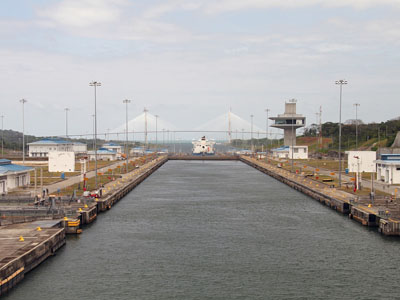Panama Canal Joins Atlantic and Pacific Oceans
The Panama Canal in Central America and was opened in 1914 after taking about seven years to construct. The canal is a short cut for ships between the Atlantic Ocean and the Pacific Ocean, and saves ships from having to take the long route round Cape Horn at the tip of South America. By using the Panama Canal the sea journey from the UK to the western coast of the United States is shortened by 5,666 nautical miles.
The line followed by the canal was chosen to cross the short neck of land between South America and Central America at its narrowest point and where the mountain backbone of the isthmus is lowest. This is the point where this narrow srip of land runs roughly from northeast to southwest and the Panama Canal crosses it at right angles. This meant that the Atlantic Ocean entrance to the canal was more than 20 miles from the Pacific Ocean entrance.
The Panama Canal is 40 plus miles long and passes through some dramatic landscapes and tropical scenery. A ship coming from The Atlantic Ocean enters Limon Bay and then passes through the three Gatun locks, one after the other, to reach Gatun Lake. This lake, with a surface about 85 feet above sea level, was formed by damming the Chagres River flowing into the Atlantic. At the far end of Gatun Lake the Panama Canal passes through the hills in a cutting called the Gaillard Cut which is about 8 miles long and leads to the lock at Pedro Miguel. It takes about eight hours to pass a ship through the Panama Canal and ships can use the canal day or night. The Canal Zone is the corridor about 10 miles wide through which the canal runs and it is governed by the United States. The Frenchman, Ferdinand de Lesseps (1805-1894), made the first real attempt to cut a canal between the Atlantic Ocean and the Pacific Ocean after having already built the Suez Canal. In 1879 he formed a company to cut a sea level canal without any locks at Panama but this attempt was soon given up.
During the Spanish-American war of 1898 the United States found it awkward to have its navy divided between the Atlantic Ocean and the Pacific Ocean so tried to pursuade Colombia, in whose land the isthmus was on, to allow the canal to be built. Colombia was unwilling so the United States pursuaded the people of Panama to break away from Colombia and form their own republic. The new republic agreed to the canal being made and the US paid a large sum of money for the Canal Zone.

